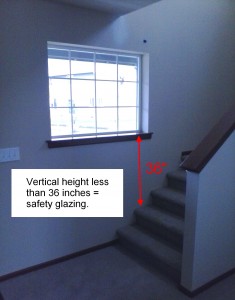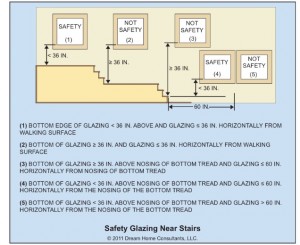A wise man once said, “It is not about the destination, it’s about the journey”, but we want to ensure your journey is safe. We’ve compiled three very important guidelines for you to safely put your best foot forward.
Stairs are probably one of the most taken for granted structural items within buildings. Often taken for granted until the railings go loose. Loose railings are not the only safety hazards possible with stairs. I’ll dig into a few of the safety hazards you want to keep an eye on.
Stairway Lighting
Proper illumination at stairs allows for visibility and safety when walking them. Stairway lighting should be at each stair section or each landing. If you’ve ever missed a step it’s probably because you didn’t see it. Proper lighting ensures you don’t fall going up or down.
The location of the light switch is important. They should be located near the entrance, so it can be used before climbing the stairs. As a safety matter there should be a light at the stairs when more than six steps are present.
Window Glass Near Stairs
You want to be careful of slips and trips especially around windows near stairs. When a person accidentally impacts glass or glazing, there are two immediate dangers. The first is from lacerations due to the large fragments of glass. The second danger is falling through and falling from the window. Safety glass, or what’s called glazing in construction circles, prevents these two dangers. Safety glazing is required at:
- Windows and doors adjacent to stairs, landings, and ramps.
- When the bottom edge of the window is less than 36 inches above an adjacent walking surface,
- The window is within 36 inches horizontally from a walking surface
- No rail is installed between the glazing and the walking surface.
Safety glazing won’t break into large sharp pieces.
Handrails
Neglecting to use handrails is a very common contributing factor to stairway injuries. The prime function of the handrail is balancing support while going up or down stairs. It is therefore crucial to be able to grasp it quickly, easily, and firmly if you are to start losing your balance. It is important to have handrails on all stairways with two or more steps and on intermediate landings. This will help people with reduced mobility, such as the elderly, the disabled, and young children use stairs safely. Also, if you wake early and don’t use the light at the stairs or need a little help up the stairs after a long day, the handrail becomes your best friend preventing embarrassing falls. Trust me.
According to the Center for Disease Control and Prevention and the National Center for Injury Prevention and Control, each year, 2.5 million older people are treated in emergency rooms for fall injuries. In fact, falls are the leading cause of fatal and non-fatal injuries for older Americans. Falls can threaten seniors’ safety, independence and generate enormous economic and personal costs. By making sure handrails are sturdy, you can prevent your older loved ones from potential risks and dangers on the stairs.
Deficiencies in design, lighting, visibility and attention are almost always the culprits in stairway slips, trips and falls. Older homes and stairs that are inconsistent should be replaced with correctly built stairs right away; especially if they are in a home or apartment with elderly users. Use of non-slip surfaces on steps can also help prevent accidents, and always make certain stairways are well lit. By following these preventive measures you can stay one step ahead at stairway safety.




















You should participate in a contest for one of
the finest websites on the internet. I’m going to recommend this
site!
Thanks! Were going for the GOLD this year!
Good information. Blessed me I reach on your site by accident, I bookmarked it.
Sometimes mistakes are our best teachers 🙂 thanks!